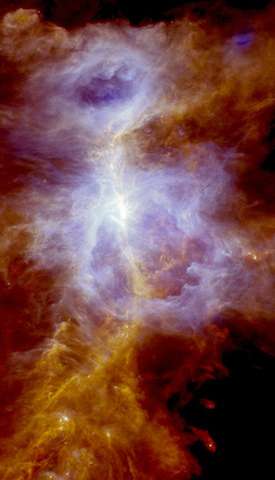 The Orion molecular cloud see http://phys.org/print352106488.html. It seems observations from the Herschel space observatory has revealed our galaxy is threaded with filamentary structures on every length scale. They vary in size and some of them are gigantic, stretching hundreds of light years across the Milky Way's spiral arms.
The Orion molecular cloud see http://phys.org/print352106488.html. It seems observations from the Herschel space observatory has revealed our galaxy is threaded with filamentary structures on every length scale. They vary in size and some of them are gigantic, stretching hundreds of light years across the Milky Way's spiral arms.
The Herschel data has caused astronomers to address filaments in space and they are now being studied intensively. They emphasize they play a crucial role in star formation.
Stars are born in dense pockets of the interstellar medium, a dffuse mixture of gases and dust that pervade galaxies, including our own. One of the problems of astrophysics is how this material can come together to create dense concentrations that later evolve into compact cores – and finally, into stars.
One way to study molecular clouds is by the use of the infrared light and this has proved successful at the ESA Herschel space observatory. It has been what is known as a game changer. Probing the portion of the electromagnetic spectrum that ranges from far infrared to sub millimetre wavelengths, it has collated data over the last 3 and a half years and one big aspect that has emerged is the presence of a filamentary network nearly everywhere in our galaxy's interstellar medium. These structures are closely bound up in the formation of stars. They have also shown that these filaments can vary in length – but they have a universal width of about a third of a light year. So what is going on?
Filaments also appear to be riddled with compact cores (or clouds of dust and gas) which indicates the filaments are actually creating stars – somehow. However, there are also regions of tangled filaments that display no sign of on going star formation. It is being suggested that turbulent motions of interstellar gas and dust create a web of filamentary structures but at that point gravity takes over – so they are still clinging to the shirt tails of the consensus. Gravity causes the densest of the filaments to fragment and contract which eventually leads to the formation of stars by accretion.
This subject can also be seen on the Thunderbolts forum (up for discussion) – if you want to see what the Electric Universe version of what has been found
